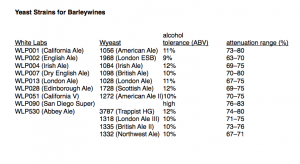This article is part of a series on barleywine.

Conducting an orderly fermentation is key to brewing a quality barleywine. The biggest key to doing this at home is to make an adequately-sized yeast starter and pitch enough yeast.
Making the wort for a barleywine can be trying. Sometimes the amount of grain required is more than your mash tun can hold. Sometimes you can’t collect all the wort you’d like because your kettle is too small. And for most all-grain versions, you need to boil the wort for an extended period of time. Even though wort production can be a chore, the part of brewing a barleywine in which the brewer can exercise the most influence on the quality of the final product is the next step — fermentation. If you make a yeast starter that is large enough, your fermentation can be handled like most ale fermentations, especially for smaller barleywines. For the largest barleywines, you may need to use some additional techniques to get all you want from the yeast,
Your Goals
Once the wort is chilled and in the fermenter, it’s time to let the yeast transform the wort into beer. In a barleywine fermentation, you have several goals. As with any fermentation, you want active fermentation to begin quickly. If your barleywine has a cap of kräusen and your airlock is gurgling between 8 and 16 hours after pitching the yeast, you’re doing great. If it takes longer than 24 hours to start, you may be headed for problems. (At a minimum, this could lead to a sluggish fermentation that takes longer than it should to finish). Likewise, once started, you want the fermentation to keep moving steadily until the beer’s target final gravity (FG) is reached. Most barleywines should finish in the high teens through the 20s. (The BJCP gives FG 1.018–1.030 for English barleywines and FG 1.016–1.030 for American barleywines as the proper range.) For beers at the lower end of the barleywine OG range (OG 1.080–1.090), this means you want a maximum apparent attenuation of around 75%. For heavier barleywines, apparent attenuation up to 80% is OK. The biggest key to achieving this is to pitch an adequate amount of yeast. Choosing an appropriate yeast strain is also important.
Yeast Strain

Recommended yeast strains for barleywine fermentations. Click picture to enlarge. (Alcohol tolerances from Wyeast, except for WLP090. Attenuation range from Wyeast and White Labs. Yeast strain equivalencies from Kris England via mrmalty.com.)
Almost any beer yeast strain can ferment an 8% ABV beer (at the bottom of the ABV range for barleywines). Near the top end of the range, around 12%, you’re better off choosing a yeast strain that is known to be alcoholic tolerant. In either case, check that the usual level of apparent attenuation will land the beer in the appropriate FG range. (Essentially, don’t use very highly-attenuating yeast strains on the smallest barleywines or very lowly-attenuating yeast strains on the biggest. Stick to middle-of-the-road attenuaters.)
Pitch Enough Yeast
Higher gravity worts require more yeast for an orderly fermentation (one that starts quickly, proceeds without stalling and reaches a reasonable final gravity in a reasonable amount of time), compared to low gravity worts. For most ale strains, you will need an initially well-aerated yeast starter ranging from 3.2 qt. to 7.6 qt. (3–7.2 L) for 5-gallon (19-L) barleywines with OGs of 1.080–1.120. Very roughly, start with a 3 qt. (~ 3L) starter for an OG 1.080 barleywine and add a quart for every 10 “gravity points.” Make the starter wort around SG 1.020, aerate this wort well before you pitch the yeast, and swirl the starter a couple times a day to keep the yeast in suspension.
If you want your barleywine to be comparatively “clean” (low in esters), given your chosen yeast strain, you can make your yeast starter somewhat larger — up to twice the recommended size. In contrast, if you want a fruity barleywine, you’re better off choosing a yeast strain that leaves a lot of esters than trying to underpitch and bump up ester production by making the yeast struggle.
When it’s time to pitch, pour off all the starter beer and pitch only the yeast slurry. You don’t want to dilute your high-gravity barleywine wort with low-gravity starter beer. If you’re going to perform a forced fermentation test (see below), add about 10% to the size of your yeast starter.
Aerate Well
When it’s time to pitch, aerate the wort well. For a barleywines in the lower half of the OG range (1.080–1.100), a single shot of aeration is likely all that you will need. For the biggest barleywines, a second shot of aeration, several hours later — once fermentation has started, but ideally before high kräusen — can help the yeast. Do not aerate the wort after high kräusen. This can lead to excess diacetly production. The biggest barleywines may also benefit from splitting the yeast nutrients into 2 aliquots and adding the second half of the yeast nutrients along with the second shot of oxygen.
Tomorrow, I’ll conclude the discussion of fermentation.
—
Related articles
Five Tips for Fermenting Big Beers

Speak Your Mind